
Rare Books and Manuscripts
In 1897, when the Library moved out of the Capitol into its own building, now named the Thomas Jefferson Building, one of the new departments created was the Manuscript Division. In the magnificent new building, European in style and in orientation, European rare books and manuscripts henceforth figured prominently in the collections. A history of remarkable acquisitions involving many generous donors has created at the Library of Congress one of the stronger collections of European rare books in North America and important collections of manuscripts and other rarities that are European either in origin or in focus.
European rarities, in book and other print formats and in manuscript, are held both in specific collections and in more general collections throughout the Library. Overall, they support a full chronological, geographical, and subject range of studies. First, early, or other rare editions of milestones in classical and European thought are basic to the Library's European holdings of rare books. Thus, the Library holds rare editions of writers such as Herodotus, Lucretius, Augustine, Andreas Vesalius, Nicolaus Copernicus, Ignatius of Loyola, Francesco Guicciardini, Giorgio Vasari, Tycho Brahe, René Descartes, William Harvey, Jacques-Bénigne Bossuet, Giambattista Vico, Linnaeus, Montesquieu, Edward Gibbon, Immanuel Kant, Mikhail Lomonosov, Edmund Burke, Mary Wollstonecraft, John Keats, Fyodor Dostoyevsky, Jacob Burckhardt, Johann Wolfgang von Goethe, Taras Shevchenko, Sarah Bernhardt, Marie Curie, Sigmund Freud, Thomas Mann, Ortega y Gasset, and Vladimir Nabokov.
In 1926 the Library published a desiderata list of what Librarian of Congress Herbert Putnam termed "bibliographical monumenta, which should indisputably be represented in the National Library of the United States." Putnam felt that Americans should be able to turn to the Library of Congress as an ultimate resource in the same way that Britons were able to turn to what was then called the British Museum Library (now the British Library). This list, which includes American, European, and Hebrew-language titles, has served as a major collection focus of rare European works. Over the years through gifts and purchases the Library has been able to acquire many of them.
Among the Library's rare book and manuscript strengths and acquisition focuses are subjects such as European law, European music, the history of science and technology, historiography, travel literature, the Reformation, European exploration and settlement, European documentation related to American history, gastronomy, magic and spiritualism, the French Revolution, Russian history and literature, Freud, the Third Reich, and diplomatic relations between the United States and the countries of Europe.
Early legal material provides valuable resources for the study of European cultural and social history and documents early European government and the origin of legal codes that later extended well beyond Europe. The Library holds major collections of Roman law, canon law, and consilia and the largest collection outside France of French coutumes--local customary laws. Treasures include a thirteenth-century vellum manuscript of Justinian's Institutes cum glossa Francisci Accursii; the beautifully illustrated Grand Coutumier de Normandie; a ca. 1500 manuscript of the Sachsenspiegel, the oldest German law code, compiled between 1220 and 1235; a first edition of De Jure Belli ac Pacis by Hugo Grotius, published in 1625; and the oldest East European code, compiled in the eleventh and twelfth centuries, the Russkaia Pravda.
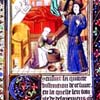 Grand
Coutumier de Normandie (1480). An illustration of early customary
law, this miniature depicts a bailiff and several knights visiting a sickroom,
probably to verify that the defendant is too ill to appear in court. (Law
Library, Rare Book Room)
Grand
Coutumier de Normandie (1480). An illustration of early customary
law, this miniature depicts a bailiff and several knights visiting a sickroom,
probably to verify that the defendant is too ill to appear in court. (Law
Library, Rare Book Room)
The John Boyd Thacher collection of manuscripts includes European autographs from as early as the fourteenth century, including European monarchs such as Charles V of France, Elizabeth I of England, and Frederick the Great of Prussia. The early documentation of European cooking begins with the Library's mid-fifteenth-century Italian manuscript "Libro de arte coquinaria" of Maestro Martino and is also well illustrated by the Dutch wood-block book Hier beginnt eenen nyeuwen coock boeck . . . y Gerardus Vorselman (Antwerp, 1560).
The Library's collection of incunabula--the largest in the Western Hemisphere-- includes examples from approximately two- thirds of about 1,080 known European presses of the fifteenth century, in-depth representations of every aspect of fifteenth- century printing, and books of outstanding importance in extraordinary condition. Here we can only skim the surface of the remarkable riches of the Library's treasures from this era. They include one of the three known complete copies of the Gutenberg Bible printed on vellum (1454-55), the first European book printed from movable type, found in the Vollbehr Collection; Guillelmus Duranti's Rationale divinorum officiorum([Mainz]: Johann Fust and Peter Schoeffer, 6 October 1459) in the Thacher Collection; and Fust and Schoeffer's 1462 Latin Bible (Mainz: Johann Fust and Peter Schoeffer, 14 August 1462) in the Rosenwald Collection. The 1488 Paris edition of Olivier de La Marche's Le Chevalier délibéré, considered the finest illustrated French book of the fifteenth century (Paris: [Guy Marchand or Antoine Caillaut] for Antoine Vérard, 8 August 1488) is found in the Rosenwald Collection as well, as are Dante's La Commedia with copper engravings ascribed to Baccio Baldini (Florence: Nicolaus Laurentii, Alamanus, 30 August 1481) and the chess game De ludo scachorum ([Bruges: William Caxton, after 31 March, 1474]).
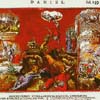 Dutch
Bible (Amsterdam, 1702). This Bible, the first to include a map, has
over 160 hand-colored illustrations by Romeyn de Hooghe, perhaps the most
significant Dutch book illustrator of the late seventeenth and early eighteenth
centuries. Folio no. 149 shows Daniel in the lion's den. (Rare
Book and Special Collections Division)
Dutch
Bible (Amsterdam, 1702). This Bible, the first to include a map, has
over 160 hand-colored illustrations by Romeyn de Hooghe, perhaps the most
significant Dutch book illustrator of the late seventeenth and early eighteenth
centuries. Folio no. 149 shows Daniel in the lion's den. (Rare
Book and Special Collections Division)
In 1993, the Library acquired another extremely rare example of fifteenth-century printing, a pamphlet commissioned by King John II of Portugal and presented by the leading Latinist of the Portuguese court, Vasco Fernandes--Velasci Ferdinandi vtriusique iuris consulti illustrissimi regis Portugallie oratoris ad Innocentium.viii. pontificem maximum de obedientia Oratio [Rome: Stephen Plannck, 1488-90]. The first printed account of the Portuguese discoveries, it is an obedience oration presented to the new pope, Innocent VIII, that announces to the pontiff the inauguration of the European age of discovery. The Library's 100,000,001st item, the priceless pamphlet was acquired through a gift from John E. Velde, Jr.
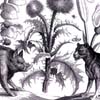 A
Boare, a Mastiff, a Thistle, an engraving by Wenceslaus Hollar,
a seventeenth-century Czech artist who emigrated from Bohemia, lived in
Frankfurt, Strasbourg, Cologne, and London, and achieved an international
reputation as a copper-engraver and miniature painter. (Prints
and Photographs Division)
A
Boare, a Mastiff, a Thistle, an engraving by Wenceslaus Hollar,
a seventeenth-century Czech artist who emigrated from Bohemia, lived in
Frankfurt, Strasbourg, Cologne, and London, and achieved an international
reputation as a copper-engraver and miniature painter. (Prints
and Photographs Division)
European religious life and art are heavily documented areas with books and manuscripts such as French books of hours; the exquisite Nekcsei-Lipócz Bible--a Latin Bible probably written and decorated in Hungary, ca. 1335-40; the Gutenberg Bible; the Giant Bible of Mainz; and many European vernacular Bibles, including the oldest Croatian book, the Missale Glagoliticum (Venice, 1483), the Czech Kutná Hora Bible (1489); the Complutensian Polyglot Bible (6 vols. [Alcala, 1514-1517]); and Ivan Fedorov's complete Church Slavic Ostrih (Ostrog) Bible of 1581. Also in the collection are early works by Martin Luther and the rare 1651 edition of Patriarch Nikon's Kormchaia kniga, a compilation of Orthodox doctrines and practices which was instrumental in creating the Old Believer schism in the Russian Orthodox Church.
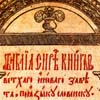 Ostrih
Bible (1581), title page. One of the greatest monuments of sixteenth-century
Ukrainian culture, this Bible has become the common heritage of all Christian
East Slavs. (Rare Book and Special
Collections Division)
Ostrih
Bible (1581), title page. One of the greatest monuments of sixteenth-century
Ukrainian culture, this Bible has become the common heritage of all Christian
East Slavs. (Rare Book and Special
Collections Division)
Rare collections of European literature and history focused on individual cultures defined by language include the Accademia della Crusca Collection, containing Italian publications ranging from the sixteenth to the nineteenth centuries, the sources from which this academy wrote its authoritative dictionary of the Italian language; the Raymond Toinet Collection, especially strong in seventeenth-century French literature; and the Francis Longe Collection of theatrical works printed in English from 1607 to 1812. Rare books by Goethe, Schiller, and Lessing, as well as an early verse translation by Johann Gustav Büschung (1815) of the Middle High German Epic Das Lied der Nibelungen, and the first edition of Goethe's Stella, Ein Schauspiel für Liebende in fünf Akten (1776) are found in the Deneke Collection. The Portuguese Manuscript Collection includes materials from 1438 to the early twentieth century relating to various aspects of Portuguese history, society, literature, religion, and culture. Several collections focus on individual European writers. One of the world's major Cervantes collections, given to the Library by Leonard Kebler, illustrates Spain's golden age and includes treasures such as the second state of the first edition of Don Quixote (Madrid: Juan de la Cuesta, 1605), identified only in this century. The George Fabyan collection, focused on cryptography, includes valuable material related to the Shakespeare-Bacon controversy. The Library's extensive collection on Rudyard Kipling, the result of several donors' bequests, includes rarities such as the earliest known draft of "Mowgli's Brothers," the first story in The Jungle Book. William Blake, Jules Verne, and Hugh Walpole are the focus of several collections. The Library also holds manuscripts of work by Shelley, Wilde, Shaw, and Ibsen.
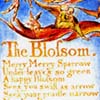 William
Blake. Songs of innocence and experience, showing the two contrary
states of the human soul(London, 1794). This "illuminated book"
was published in 1794 and hand- colored by Blake in 1826. The image of
"The Blossom" is a prime example of Blake's brilliant use of color. (Lessing
J. Rosenwald Collection, Rare
Book and Special Collections Division)
William
Blake. Songs of innocence and experience, showing the two contrary
states of the human soul(London, 1794). This "illuminated book"
was published in 1794 and hand- colored by Blake in 1826. The image of
"The Blossom" is a prime example of Blake's brilliant use of color. (Lessing
J. Rosenwald Collection, Rare
Book and Special Collections Division)
 Paul
Fargue. D'après Paris. (Paris, 1931). Paul Bonet's binding
is a striking example of art deco design. (Lessing
J. Rosenwald Collection, Rare
Book and Special Collections Division)
Paul
Fargue. D'après Paris. (Paris, 1931). Paul Bonet's binding
is a striking example of art deco design. (Lessing
J. Rosenwald Collection, Rare
Book and Special Collections Division)
European travel, exploration, and expansion are documented in rarities such as the De consuetudinibus et conditionibus orientalium regionum (Antwerp, 1483-85), a version of Marco Polo's exploits, and Bernhard Breidenbach's account of his pilgrimage to the Holy Land, Peregrinatio (Mainz, 1486). Missionary accounts dating from the sixteenth century to texts such as Pehr Högström's Beskrifning offwer de til Sweriges Krona lydande Lapmarker (Stockholm, 1747) and David Livingstone's Missionary Travels and Researches in South Africa (London, 1857) are important for the study of European exploration. The Library's varied holdings on European involvement in the Americas is discussed below in the European Americana section.
The Czech statesman Thomas G. Masaryk's complete original handwritten copy of his book Nová Evropa (The New Europe), the final version of which was completed during his stay in Washington in 1918, is an example of important facets of the history of twentieth-century Europe that are documented by several fascinating items and collections. The manuscript was donated by Masaryk's former private secretary Dr. Jaroslav Císar.
A remarkable story unfolded shortly after World War II when an American soldier saved from destruction a miscellany of books, albums, and printed materials from the Reichskanzlei Library in Berlin. Another American rescued the private book collections of several high-ranking Nazi party officials, including Hitler, Göring, and Himmler, and had the materials shipped to Washington, where, with the Reichskanzlei materials, they now make up the Third Reich Collection of the Library of Congress.
Another gripping tale from the Second World War details the background of the 1946 publication of the Ciano diaries, smuggled out of Italy after Mussolini had executed his son-in-law and former statesman Galeazzo Ciano. The story is recounted in the working papers--the Galeazzo Ciano Papers--donated in 1955 by their publisher, Doubleday and Company, Inc.
No less significant was the Library's acquisition of the papers of journalists, writers, and literary editors Janet Flanner and Solita Solano as gifts from the authors over a ten- year period (1967-77). For half a century (1925-75) Flanner wrote the column "Letter from Paris" for The New Yorker magazine. Much of the Flanner-Solano Collection relates to the literary and intellectual society and life of Paris and includes writings by and correspondence or photographs of individuals such as Aragon, Karen Blixen, Colette, Gurdjieff, Malraux, Olga Petrova, Dame Edith Sitwell, and Thornton Wilder.
The Lessing J. Rosenwald Collection, the greatest overall gift of rare books to the Library of Congress, focuses on the Western illustrated book from the fifteenth through the twentieth century. Rosenwald once remarked that "an interest in books naturally leads to an interest in the development of printing." His collection includes significant holdings of Western European type specimens, decrees governing printing and bookselling, and printing manuals from France, England, Italy, and Germany. Among its particular strengths are early wood-block books such as Apocalypsis sancti Johannis (Germany, ca. 1470) and the Nuremberg Chronicle (1493), the most heavily illustrated book from the late fifteenth century. Also noteworthy are neoclassical eighteenth- century French illustrated books. For example, the 1751 French edition of Erasmus's L'Eloge de la folie illustrated by Charles Eisen includes seventeen original drawings by the illustrator bound in. The drawings by Gravelot for Boccaccio's Decamerone, published in 1757, are also part of the collection.
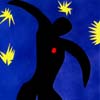 Henri
Matisse. Jazz([Paris] 1947).The only publication of which Matisse
was both author and illustrator, Jazz embodies the tradition of
the artist's book. (Lessing
J. Rosenwald Collection, Rare
Book and Special Collections Division)
Henri
Matisse. Jazz([Paris] 1947).The only publication of which Matisse
was both author and illustrator, Jazz embodies the tradition of
the artist's book. (Lessing
J. Rosenwald Collection, Rare
Book and Special Collections Division)
Another highlight of the Lessing J. Rosenwald Collection is the livre
d'artiste, a genre which was developed in France during the first quarter
of the twentieth century and then spread throughout Europe, offering examples
of modern illustration, typography, and binding. Here one comes across
works by Bonnard, Braque, Chagall, Clair, Cocteau, Derain, Duchamp, Dufy,
Matisse, Picasso, Rouault, Toulouse-Lautrec, Utrillo, and de Vlaminck.
Library of Congress (September 6, 2006) Ask a Librarian |
LC Home Page | Search the LC Catalog | European Reading Room |